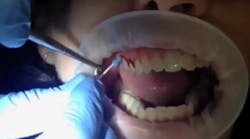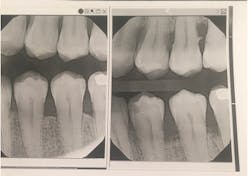Fell Sulcular Sweep: A better way to control gum disease and decay and cover floss’s shortcomings
Dentists and dental floss manufacturers have recently been discredited and maligned on National Public Radio and in print. The public has been lead to believe that flossing is of little value and dentists have not been truthful with them.
The following concept and video are a way to reestablish our credibility with the public. More importantly, we must not let our oral care become lax with this misdirection of the public based on floss’s proven shortcomings. Please consider adapting the following idea.
I have practiced in Alaska since 1968. In the mid 1980s, a patient who was flossing and brushing a couple times per day but was still having some sore and bleeding gum tissue said to me, “Hey doc—you need to find a better way for me to control my bleeding gums and cavities.” Around this time I had taken a continuing education course on “new approaches to treating gum disease.” The lecturer said, “Some bleeding from the gum tissue is normal.”
That statement did not sit well with me. Healthy, non-infected tissue should not bleed. Gum tissue bleeds because the infective bacterial biomass in and on it digest the protective epithelial covering. This causes the blood vessels to become so weakened and swollen that their permeability is increased and the vessels may burst when touched. It becomes essential to control the growth rate and numbers of this bacterial biomass if health is to be maintained in these tissues.
During this time frame, Cornell and UCLA medical schools had just released their combined findings that vascular dementia was caused by bacteria entering the bloodstream through ulcers on the side of the gum tissue that rests against the teeth and in the gum tissue’s depressions between the teeth. These ulcers, whose combined surface area may be the size of a silver dollar, are a huge doorway for bacteria to enter into the bloodstream. Once inside the vessel, they ride in the moving bloodstream into our tissues to begin their harmful growth. Further studies have shown that they are a major factor in Alzheimer’s disease, heart attacks, and strokes . . . in other words, bacteria living and reproducing in our blood stream is not compatible with good health.
In the video below, I explain these concepts, as well as the anatomy behind ulcers in the gums.
The question to be asked is, why does brushing and flossing a couple times per day not control these diseases? In the end it comes down to three reasons:
First, is the way the gum tissue grows around and attaches to the teeth. The teeth are set in a row in the jaw with a triangular space in between each pair. The pink triangular gum tissue that grows to fill up this space between each of our teeth is higher on both the cheek side and tongue side than in between the teeth. There is a depression between these two high points that is 2 to 4 mm deep. When dental floss rests on these gum tissue high points, it can never remove all the food and bacteria from this depression. This is why sore bleeding gums and decay can not be managed by floss and brushing alone.
Second, gum tissue does not attach right where we see its edge rest against the tooth, but folds over on itself before attaching to the tooth, creating a 1 to 4 mm trough all around the tooth—just like a moat around a castle. So the brush and floss must be forced down into this trough to dislodge the tissue damaging bacteria.
If you combine a 1 to 4 mm trough with the 1 to 4 mm un-flossable and/or un-brushable depression between the teeth, it leaves too much uncontrolled bacterial growth attacking our tissues to be healthy.
Third, bacteria grow very fast on carbohydrates—so fast that damage to gum tissue and teeth and bacteria entering into the bloodstream begins moments after we eat. The best thing to help our tissues is to push out the packed food and displace the bacterial colonies. We want to ideally do this food and bacterial removal after each meal.
The big question is, how can I do this? Floss won’t!
What I needed was a very slender flexible toothpick to get down to the deep parts of the gum tissue and into the trough between the teeth. It would need to have a smooth end so as not to cut the tissue and have something on the end to engage the bacteria and food mass. With some searching, I found a toothpick with a small bit of cloth fused to its end—it was invented by a Swedish dentist—so I nicknamed it the Swedish Wonder. Over the many years, I have used other picks and still call them all Swedish Wonders.
Finally, what is the better way to improve oral health?
The better way is wonderfully simple: push the food and bacteria out from the deepest recesses between the teeth as soon as possible after each meal. This will prevent the teeth from being subjected to high levels of bacteria-generated acids and enzymes that cause decay and gum tissue ulcers. The skin will grow back over the ulcers, so bacteria will no longer have these open doors to our blood stream.
The following video segments will hopefully make this simple technique easier to understand and show you what tissue health you may expect from dedication to these techniques.
In the first video, I demonstrate the use of an interdental cleaner for the first time on a patient.
In the second, you can see the difference in bleeding after the patient used the interdental cleaners for just one week.
It is very important to stress that during the first two to 10 days, some discomfort may be felt and bleeding will occur when pushing the interdental cleaner into the depths of these raw, ulcerated spaces in between our teeth. The bleeding and soreness will go away during this same timeframe and will never return if you keep with this suggested program. For my patients who use the Swedish Wonder regularly, there is a significant reduction in decayed teeth and much less need for gum surgery, year after year. So, “Swedish Wonders forever” and the very best of health to us all.
Author’s note: I know your level of oral anatomy is above what words I have used. My goal is to reach nondentists also.
William Fell, DDS, is a member of the 1968 first graduating class of UCLA dental school. He was involved with research projects on electronic patient interaction, patient data, instruction and student abilities to review all lectures after the fact at electronic libraries. He also did research to improve casting accuracy at UCLA. He has dental and nondental patents. His article, "One visit composite and amalgam bonding for strong aesthetic posterior restorations,” has been published in JADA.







